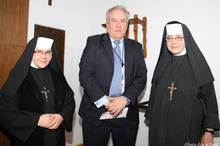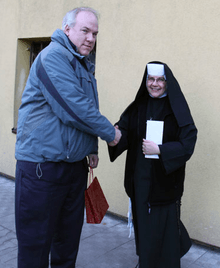Albertine Sisters
| Zgromadzenie Sióstr Albertynek Posługujących Ubogim | |
| Abbreviation | CSAPU (United States) |
|---|---|
| Formation | January 15, 1891 |
| Founder | St. Albert Chmielowski and Blessed Bernardina Jabłońska |
| Founded at | Kraków, Poland |
| Type | Roman Catholic religious institute |
Superior General | Sister Krzysztofa (Maria Babraj) |
| Website | http://www.albertynki.pl/english.php |
The Sisters of the Third Order of St. Francis Serving the Poor, commonly known as simply the Albertine Sisters, are a Roman Catholic religious institute of nuns.

History

Foundations
The founder, born Adam Chmielowski (1845-1916), came from an aristocratic Polish family. Orphaned at a young age, he grew up expecting to take responsibility for the family estates and studied agriculture to this end. The young student, however, was a strong Polish nationalist and took part in the January Uprising of 1863, in the course of which he lost a leg.[1]
Chmielowski was forced to flee Poland due to the repressive response of the Czarist authorities and moved to Belgium to continue his studies. During that period, he discovered that he had artistic talent, and began to develop that ability. By the time of his return to Poland in 1874, he was an accomplished painter, who became successful in Kraków.[1]
When he returned to his homeland, though, Chmielowski was struck at the degree of poverty he saw among the people of the country. He began to help at homeless shelters run by the city, where he grew to know the poorest segment of the population at first-hand. Over the next decade, he continued this service, while maintaining his artistic career, though he increasingly turned to religious themes.[1]
By 1887, Chmielowski had decided to abandon his career, to live among the poor and needy and to accept a beggar's life and lifestyle. On 25 August of that year, the feast of the patron saint of the Order, Saint Louis, King of France, he became a member of the Third Order of St. Francis, publicly wearing the traditional gray habit of the Order and took the name Brother Albert. He began to live in the shelters where he served, giving himself fully to the poor around him and working to give them hope.[1]
The Congregation
Upon the completion of his year of novitiate on the same feast in 1888, Albert Chmielowski was allowed to profess religious vows. At that time, he gathered other men who had expressed interest in sharing his commitment and established the Brothers of the Third Order of St. Francis, Servants of the Poor, in 1888. In the next couple of years, he worked on organizing a congregation for women to serve the poor in conjunction with his Brothers.[1] The first woman to dedicate herself to the cause was Anna Lubańska of the Podlachia region of Poland, later known by her religious name as Sister Frances.[2]
The founding date of the Albertine Sisters was 15 January 1891, when the first seven sisters, including Anna Lubańska, received their habits in the Kraków Bishops' Chapel, in the presence of Brother Albert Chmielowski and Cardinal Albin Dunajewski.[3] Officially called the Sisters of the Third Order of St. Francis Serving the Poor, the first Sisters resided in a shelter for homeless women that they founded, located in Kraków on Skawinska Street.[2]
Initially, Chmielowski had kept the congregation under his direct leadership.[2] However, as both the Brothers and Sisters grew, it is likely that this method of leadership became inadequate. On 7 April 1902, he appointed Sister Bernardina the congregation's first Superior General.[2][3] Born Maria Jabłońska, she was invested on 6 March 1897. She wrote Albert's Rule, the basis of the Constitution of the Albertine Sisters in 1917–1918, and presided over a time of significant growth. Sister Bernardina led the congregation for 38 years, until her death on 23 September 1940.[3]
As the Sisters grew in number, they opened more homeless shelters. The oldest remaining is the shelter at 47 Krakowska Street, which Chmielowski had elevated to the main shelter in 1908.[2] By 1916, they were active in the cities of Kraków, Jaroslaw, Przemyśl, Zakopane, and Kandielce in Poland, and Lviv and Sokal in Ukraine.[2] At the time of Sister Bernardina's death, the Albertine Sisters numbered 500 and ran 56 institutions.[3] On 19 June 1926, the Albertine Sisters' leadership met with Prince-Bishop Adam Stefan Sapieha as part of the approval process for the congregation. Three days later, Sapieha approved the Sisters a congregation of diocesan right.[3] On 15 June 1928, the Sisters established a new motherhouse in Kraków. It held a large chapel, and a postulate and novitiate for young entrants to the congregation.[3]
In 1947, the gradual socialization of private healthcare and other charitable institutions began. Soon, the Sisters in Poland were left with little control over many of their ministries. By now, the congregation had left Ukraine, which was much more hostile under Soviet rule than Poland, a very Catholic country. On 17 September 1955, the Holy See approved the Albertine Sisters a congregation of pontifical right, moving them from under the authority of the Archbishop of Kraków to the direct authority of the Pope. Ten years later, the Holy See gave official approval of the Constitution of the Albertine Sisters.[3] On 19 March 1957, the congregation split into two provinces, Warsaw and Kraków.[3]
In response the Second Vatican Council, in the 1970s, the Albertine Sisters began to spread from Poland to other parts of the world, first setting up institutions, and later beginning to grow as native-born women joined their ranks. The congregation spread to the following places in the following years: Rome, Italy on 29 December 1972, the United States in 1974, Argentina in 1982, Bolivia in 1991, Ukraine in 1992, Slovakia in 1995, Siberia, Russia in 2001, England in 2002, and Vatican City in 2003.[3] On 18 June 1982, the Albertine Sisters' new constitution was approved by the Congregation for Institutes of Consecrated Life and Societies of Apostolic Life. It included changes to bring the congregation's way of life further in accordance with the recommendations and requirements of the Second Vatican Council.[3]
On 15 January 1991, the Albertine Sisters celebrated the centenary of the congregation.[3]
Recent times
At the present time, the Albertine Sisters administer 69 foundations. Poland holds 53 of these, and the other 16 are distributed in Argentina, Bolivia, England, Italy, Russia (Siberia), Slovakia, the United States, Ukraine, and Vatican City.[2]
Superior Generals
- Blessed Sister Bernardina (1902–1940)
- Sister Krzysztofa (?–present)
References
- 1 2 3 4 5 "The Albertine Brothers - Congregation of the Brothers of the Third Order of St. Francis". www.albertyni.opoka.org.pl. Retrieved 2016-01-23.
- 1 2 3 4 5 6 7 "Albertine Sisters". www.albertynki.pl. Retrieved 2016-01-23.
- 1 2 3 4 5 6 7 8 9 10 11 Jaroś, Ireneusz. "Albertynki". www.albertynki.pl. Retrieved 2016-01-23.